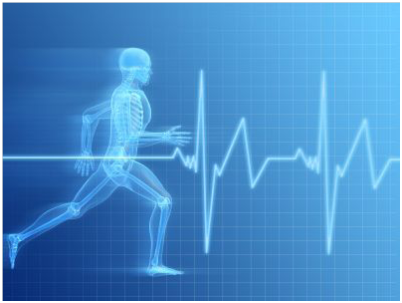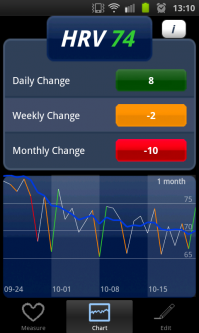by Josh Darrall-Jones
Who, Why & What?
 The authors of the paper, (James et al., 2002) wanted to understand how an interval training session similar to that implemented in endurance runners to improve VO2MAX would affect disturbance in HRV one hour post exercise and whether it had returned to baseline at 72 hours post exercise.
The authors of the paper, (James et al., 2002) wanted to understand how an interval training session similar to that implemented in endurance runners to improve VO2MAX would affect disturbance in HRV one hour post exercise and whether it had returned to baseline at 72 hours post exercise.
The study was completed using 8 healthy, trained males, with the aim to track Heart Rate Variability (HRV) following a typical training session that is implemented in middle distance runners.
It is well known that endurance athletes must complete a varied training regime with four intensity zones highlighted; easy, steady, tempo & interval. These intensity zones can only truly be identified using a maximal oxygen uptake laboratory protocol (VO2MAX) to measure running speed, oxygen uptake (VO2), and track the lactate response to the intensity of exercise; however the majority of serious endurance athletes will attempt to complete a mixture of these training sessions per week based on a time per meters ran.
It is generally accepted and implemented in the endurance exercise community that training should be split, with the majority, ~75% at low intensity (easy & steady zones) with only ~10-15% at high intensities (tempo and interval zones), with the high intensity training sessions having the largest affect upon VO2MAX, while causing the largest fatigue.
Therefore the planning of high intensity sessions such as that implemented in the present study, must allow adequate recovery so that subsequent training sessions can be completed optimally to minimise this fatigue.
The participants in the present study completed a graded treadmill testtest allowing the researcher to identify both VO2MAX & velocity at VO2MAX (vVO2MAX). Seven days later the participants returned to the laboratory to complete the training protocol consisting of 6 x 800m intervals at 1 km·hr-1 below vVO2MAX, with 3 minute rest periods.
Heart Rate Variability was measured 1 hour pre exercise, 1 hour post exercise and at 72 hours post exercise. Time domain (RRSD) and frequency domain (LFms2, HFms2, Total Power ms2, LFnu, HFnu and LF/HF) measures were collected.
What did they find?
Following completion of the training protocol the author reported that RRSD was reduced significantly at 1 hour post exercise in comparison to the pre test measure (75 vs. 57 ms). This was coupled with an increased resting heart rate (HR) which was significantly different from pre to one hour post exercise (69 vs. 77 b·min-1). The change in RRSD is likely linked to the increased heart rate resulting in reduced R-R intervals suggesting an increase in sympathetic nervous system activation. At 72 hours both RRSD and heart rate had returned to baseline values (HR decreased significantly; 65 b·min-1, RRSD increasing significantly; 83ms).
Measures in the frequency domain were only significantly changes when expressed as ms2 with significant decreases at one hour post in both LF (3640 vs. 1961ms2) and HF (886 vs. 191 ms2); which then significantly increased at 72 hours post exercise (LF, 4839 ms2; HF, 639 ms2). However interpreting these changes is difficult due to a decrease in total power from pre to one hour post (6257 vs. 3831ms2) increasing again at 72 hours (7800ms2).
Understanding the results and implications
 The results of the paper suggested that following a high intensity interval training session at an intensity of 1 km·hr-1 below vVO2MAX, that the ANS is disturbed at one hour post exercise and that it recovers within a period of 72 hours. This is reflected in the increased HR and reduced RRSD at one hour post exercise, suggesting increased sympathetic activity, which then elicited a rebound effect at 72 hours post exercise.
The results of the paper suggested that following a high intensity interval training session at an intensity of 1 km·hr-1 below vVO2MAX, that the ANS is disturbed at one hour post exercise and that it recovers within a period of 72 hours. This is reflected in the increased HR and reduced RRSD at one hour post exercise, suggesting increased sympathetic activity, which then elicited a rebound effect at 72 hours post exercise.
While the changes in HRV indices in the frequency domain were significant when reported as ms2, the reduction in total power needs to be accounted for to observe real change. This was not reported in the findings; therefore the reader is left unaware of any real disturbance to the ANS through any specific frequency representing parasympathetic or sympathetic nervous system.
Despite this methodological flaw all HRV indices returned to similar to baseline values at 72 hours, suggesting that the participants had recovered from any disturbance to the ANS resulting from the training, meaning they were ready to train intensely again.
The implications of the findings suggest recovery from interval training is completed within 72 hours, possibly earlier, however due to a lack of measures we are unaware of this. It further rationalises the use of longitudinal tracking of HRV for athletes, so that they and their coaches can understand when to increase or decrease training load.
For example in the endurance training scenario, with only a small percentage of training in the high intensity zones, it may be plausible for the coach to assign these days when the athlete presents with a high HRV. The theory for this would suggest that as they will accumulate fatigue and disturb the ANS through the training session, their HRV value will drop the following day. However as they have trained at a peak in their HRV this drop may not exceed their personal HRV threshold that would suggest or elicit a state of accumulated fatigue or overtraining. This would then allow the proceeding training sessions to be assigned into the low intensity zones of easy and steady, similar to recovery runs, while their HRV recovered from the intense training session.
For training planning to be implemented in such a way it would be necessary for the athlete to collect HRV data daily to determine an average and standard deviations of this average. For example if your average morning HRV score is 72 with a standard deviation of 15 the high end suggesting you can train hard would be a morning score of 87, whereas if you present with a morning HRV of 57 it would suggest you should take a rest day. This would allow the coach to plan training not only around the average score but also the extremes of the average represented through standard deviations.
Both approaches to training planning would essentially require longitudinal tracking of HRV so that coaches could understand when to implement the rest days, high intensity sessions or recovery sessions with confidence to optimise the athletes adaptation to training while reducing the chances of overtraining. This further allows individualised training for each athlete and dispels the one size fits all approach to training.
Layman lowdown
If you are an endurance athlete completing tempo or interval runs, you must be aware of the increased levels of fatigue associated with this type of training, which will be reflected in a decrease in HRV. It is likely that you will be recovered within 72 hours and possibly earlier; this can be tracked by measuring HRV daily to see how your daily score recovers. It is likely that if you are a serious endurance athlete that you will train upto 6 days per week with a mixture of weights and running/ cycling or swimming. If this is the case, plan for the day following your tempo or interval training to be a rest day, where you can refuel, address soft tissue problems stretching and foam rolling, get adequate sleep and have a day lifting no weights.
Why not try to implement your tempo and interval runs when you present with a high HRV score above your average and track your recovery in comparison to previous sessions? Or calculate your average and standard deviations using excel and use these extremes (standard deviation scores) as your indicator to train hard, or take a day of complete rest?
To read the HRV research paper
A little info on the reviewer
 The reviewer of the above article is called Josh Darrall-Jones, a MSc Exercise Physiology graduate and Strength & Conditioning coach with Leeds Carnegie RFU Academy, Leeds Metropolitan University Rugby League and Women’s Rugby Union, as well as lead S&C coach for the MCCU Leeds Bradford Cricket Team who play professionally on the County circuit.
The reviewer of the above article is called Josh Darrall-Jones, a MSc Exercise Physiology graduate and Strength & Conditioning coach with Leeds Carnegie RFU Academy, Leeds Metropolitan University Rugby League and Women’s Rugby Union, as well as lead S&C coach for the MCCU Leeds Bradford Cricket Team who play professionally on the County circuit.
He is based in Leeds and can be contacted via email, jddj_18@hotmail.com or twitter, @J_Darrall_Jones for one to one Strength & Conditioning coaching or group training.
He researched HRV for his MSc thesis and titled the study “Acute effects of high intensity intermittent running training protocols upon heart rate variability (HRV)” and can be consulted on methodologies for BSc and MSc studies, as well as for club coaches needing to understand how, when and why they should be using HRV to optimise training.

 If you take the time to implement the above suggestions you are likely to see an upward increase in your HRV during the week of relative rest, with this gradually reducing during the next training block as you accumulate fatigue. Further measurement during the end of this block; another week of relative rest, should elicit the same response with further upward trends in your HRV score, beyond that previous. Using the colour coded system built into the ithlete system during your training blocks, alongside training the extremes of the mean (standard deviations) may in fact mean that you do not need to train as much, but are optimising your time to get similar or better adaptations. You do not always need to train hard, but you always need to train SMART!
If you take the time to implement the above suggestions you are likely to see an upward increase in your HRV during the week of relative rest, with this gradually reducing during the next training block as you accumulate fatigue. Further measurement during the end of this block; another week of relative rest, should elicit the same response with further upward trends in your HRV score, beyond that previous. Using the colour coded system built into the ithlete system during your training blocks, alongside training the extremes of the mean (standard deviations) may in fact mean that you do not need to train as much, but are optimising your time to get similar or better adaptations. You do not always need to train hard, but you always need to train SMART!
Great read as I was searching for a more thorough understanding of the ithlete software calculations. Now I can calculate standard deviation for my readings & use it to determine my interval days!